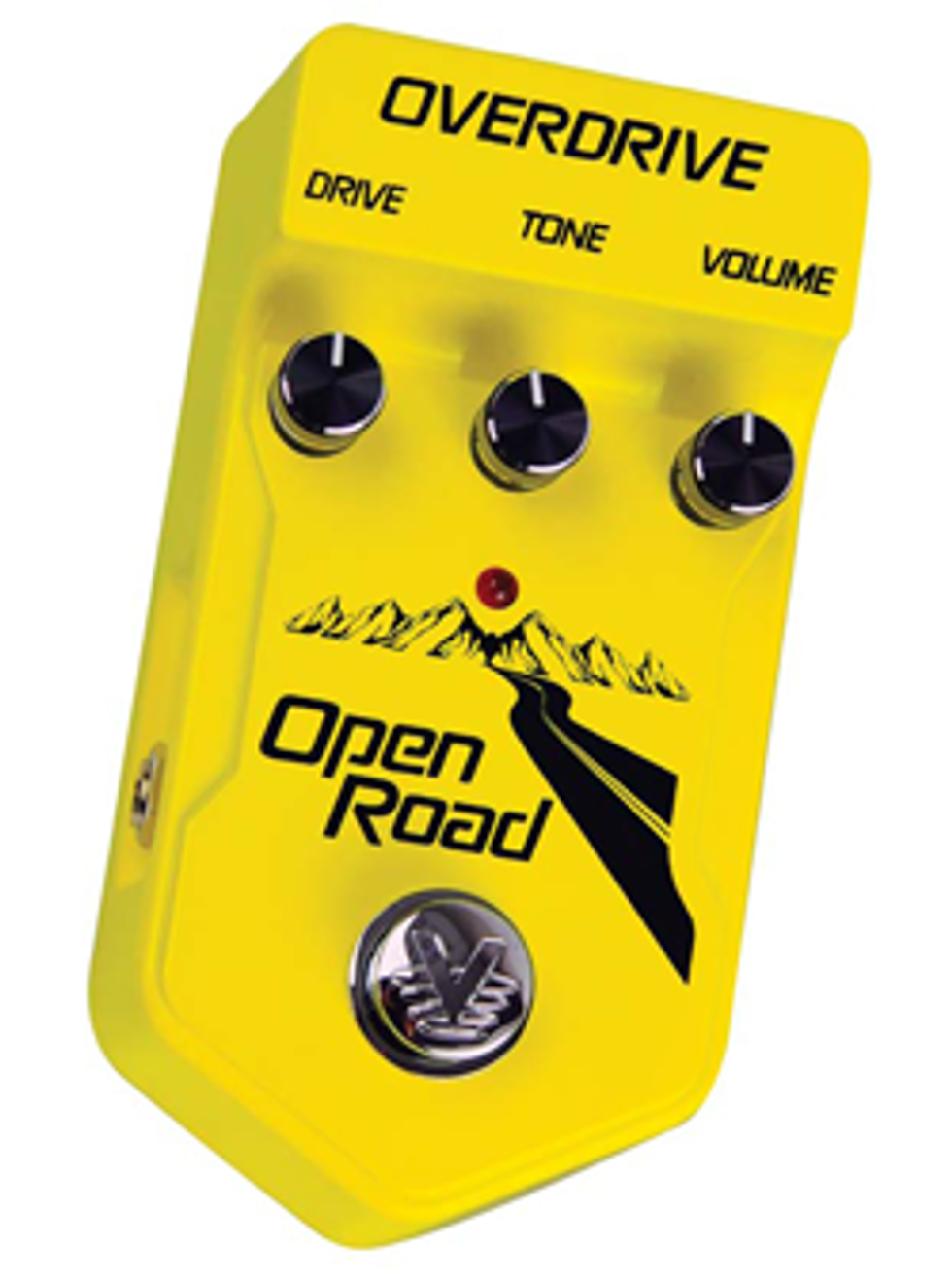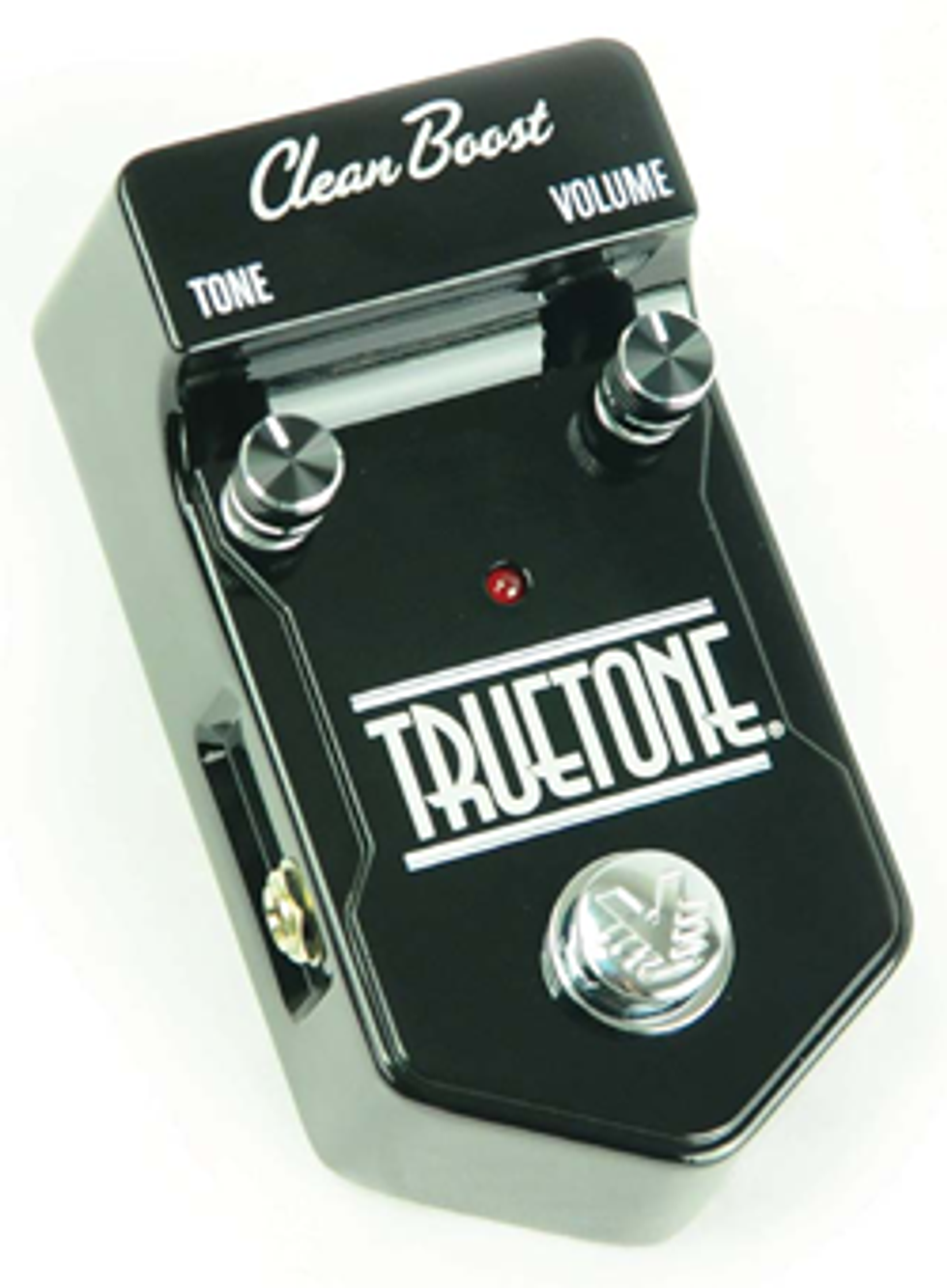The Open Road Overdrive and Truetone Clean Boost are useful, affordable tools that play well together.
| Click here to download a jam recorded by the reviewer using both pedals. |
The folks at Visual Sound have an uncanny understanding of the road warrior musician, and what makes him tick. They seem to really get the degree to which guitarists lean on their pedals for their signature tone. Visual Sound’s latest salvo into the extremely competitive stompbox market is their Truetone Clean Boost and Open Road Overdrive pedals. Let’s hit the road, and put the pedal to the metal—and the pedals to the test.
 |
|
| Download Example 1 |
|
Visual Sound’s newest overdrive unit is a refinement of the company’s earlier Route 808 Overdrive, which itself was a wellcrafted clone of the classic Ibanez TS-808 Tube Screamer. The Open Road Overdrive is a new animal entirely, primarily because it addresses the shortcomings in its predecessors. One of the most frequent gripes about stompbox overdrives is their overabundance of midrange frequencies. The midrange spike can really build up in the studio come mix time, and it can take its toll on stage, even though lots of mids are a natural outgrowth of the way an overdrive clips the incoming signal.
The Open Road does well to preserve the fundamental frequencies—the bottom end—while delivering the flavor up top, and the Tone knob adds sparkle to the top end when turned clockwise, but without adding an overabundance of midrange. At no time did the tone become obnoxious or overbearing. The engineers at Visual Sound have done a nice job here, making this dial more than just the sonic equivalent of choosing between a fine or coarse cheese grater.
With the Drive dial cranked, the Open Road oozed with plexi goodness, especially when goaded by a Les Paul Custom loaded with humbuckers. With an American Strat packing traditional single coils and the Drive knob set less aggressively, we found ourselves squarely in classic Fender Twin territory. The one thing the Open Road doesn’t do is the over-the-top shred fest; if you’re looking for a box to deliver apocalyptic metal mayhem, this is not it.
The Volume knob allows you to control how hard you hit the amplifier’s preamp stage, and thus further invites you to dial in more tone. I tested the Open Road with a Line 6 Spider Valve 1x12” amp, which has a tube preamp, a tube power amp, and 12 digital amp models. We set it on the “plain Jane” vanilla clean setting, the least forgiving setting for a unit like this (in fact, the sound clips were recorded entirely from the Line 6’s high-Z line out and the clean amp model). The Volume control helped beef up the output nicely.
Larger boxes, like the Visual Sound housing, do take up more space on the pedalboard,and if they’re made with the requisite robustness that roadwork requires (this one is), they’re also heavier. I favor the larger boxes for their ruggedness. Moreover, the Visual Sound Open Road has a substantially wider button, which looks like mil-spec hardware left over from the Soviet space program.
Above all else, I came away with the sense that the Open Road was more of an amp simulator than a distortion box. The Tone knob took on many characteristics of a tube amp’s presence control, while the Drive knob acted like an amp’s hot channel preamp gain stage. Lower settings produced the smokey sounding onset of clipping that is normally heard from a tube amp on the brink of breakup. It was easy and fun to flirt with that edge with some dynamic picking, or by rolling into the guitar’s volume control. The Open Road Overdrive has a fat, ballsy tone that doesn’t shortchange the often-neglected bottom end. It’s got a presence that shimmers up top, without sounding plastic or transistorized. It’s going to give you a reliable, organic, authentic tube-amp tone from even the cheesiest solid-state ’80s amp.
Buy if...
you're looking for a well-rounded, organic tube-amp-style overdrive.
Skip if...
death metal is your thing, and you consider yourself the spawn of Satan.
Rating...

|
MSRP $119 - Visual Sound - visualsound.net
|
 |
|
| Download Example 2 |
|
The Visual Sound Truetone Clean Boost pedal is deceptively simple: two knobs, and an On/Off button. That’s it. It’s like a supercharger bolted to an already healthy V-8 engine. It will boost everything by a factor that can be set with the Volume knob. Whatever tonal nuances you bestow to your incoming signal will be amplified or accentuated. In point of fact, the Truetone Clean Boost is two tools in one. In its simplest guise, it’s a high-gain preamp. In a world of complex digital effects with computers running algorithms, the Clean Boost might seem a bit of a throwback, but for the vast majority of road-going bands, there’s no monitor engineer, or even a mix engineer. If you need to step up for a solo, you need to be able to just hit the gas and go.
This pedal is best with an amp with lots of headroom. A boost to the incoming signal isn’t going to be terribly effective if the power amp is sending out a clipped signal. In recent years, there has been a trend towards using very clean tube power amps with all of the tone sculpting coming from pedals and other outboard gear. Players who value dynamics get the maximum benefit, and the tube saturation of the amp is still an integral part of the sound.
When used as a quasi-overdrive, the Clean Boost excels, provided it’s hitting the “right” preamp. The Clean Boost provides a fat, mostly unadulterated signal (depending on the tone setting). If you’ve got vintage tweed, a plexi, or any type of warm, multistage tube amp, the Clean Boost is going to catapult you into the pleasure zone without making your ears bleed. The simple Tone knob works best when conceptualized in the classic sense of an equalizer—tamping down a high end that’s too strident, or adding some sharpness to a dull, swampy signal. When positioned between a Stratocaster and the Line 6 Spider Valve combo amp, the Clean Boost beefed up the bottom end, hitting the preamp hard for some authentic, old-time overdrive. In this situation, the tone control allowed me to roll off some extra high end which was having an undesirable effect on the natural overdrive of the amp. When the Strat was switched out for the Les Paul Custom, I needed some extra high-end boost.
Like the Open Road Overdrive, the Truetone Clean Boost also gets the benefit of Visual Sound’s formidable housing and robust foot switch. But the aluminum shell of the Truetone’s volume knob had come unglued from its plastic core. The metal knobs are cosmetic caps that are glued onto the plastic core, into which the metal shaft of the pot is locked. According to Visual Sound, this is a rare problem that occurs during shipping, and they will replace any defective knobs.
Buy if...
your amp or overdrive unit needs an extra kick in the pants at just the right time.
Skip if...
you've got a channel-switching tube amp with great gain staging options.
Rating...

|
Street $99 - Visual Sound - visualsound.net
|
The Final Mojo
Armed with just the Open Road Overdrive and the Truetone Clean Boost, I’d feel confident walking into any joint, plugging them in to any random guitar amp and laying down some righteous jams. With the Open Road Overdrive punching up the bottom (while keeping the top sizzling along), it all promises to be a fun-packed, high-speed road trip. The Truetone Clean Boost likewise will provide serious passing power on your musical highway when you need it the most. In the studio, we were rewarded with inspiring tone right out of the box—even when our test units were placed at a tonal disadvantage. These are workhorse pieces at a terrific price, and if you’re the kind of guitarist who likes to toneshape with foot pedals, both of these will provide rewarding jams.
Editor’s note: the print version of this review originally contained incorrect information regarding the Volume knob of the Truetone Clean Boost, the aluminum shell of which came unglued from its plastic core during shipping. The html version of the review has been corrected. We regret the error.


